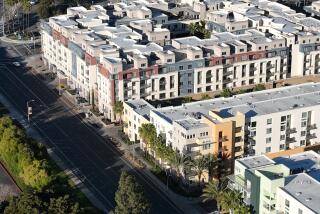Pace of foreclosures slows in California
Signs are emerging that a much-feared escalation of California home foreclosures may not happen, as banks respond to government pressure and scale back their repossessions of troubled properties.
Statewide, the number of homes taken back by lenders dropped sharply in the three months ended Sept. 30, falling 37% over the same period a year earlier, when foreclosures were at an all-time high.
If the trend continues, it will give momentum to the fledgling recovery in the housing market. Although home prices appear to have bottomed out in much of the state, industry analysts have cautioned that a glut of foreclosed properties coming on the market could send values plunging again.
“I certainly don’t think there’s going to be a deluge, or second wave of foreclosures,” said UC Berkeley economist Kenneth Rosen, who believes federal officials will do whatever it takes to see the backlog of foreclosures clear gradually. “There’s now an appetite to make sure we get this right.”
Hundreds of thousands of Californians remain at risk of foreclosure because they can’t make the payments on their homes. Yet lenders are now more willing to give borrowers time to catch up with their payments, partly out of concern that more foreclosures will further depress the housing market -- and the value of their inventory.
“It’s not out of the goodness of their hearts,” John Walsh, president of MDA DataQuick, which provides real estate research, said of lenders’ reluctance to foreclose. “It’s because they’ve concluded that flooding the market with cheap foreclosures in this economic environment may not be in their best financial interest.”
Bank of America Corp., one of the nation’s biggest lenders, said the slowdown in foreclosures could be attributed to efforts to “exhaust every possible option” to keep borrowers in their homes.
“We do not hold foreclosed properties off the market,” the bank said in a statement. “We have an obligation . . . to prepare foreclosed properties for market and sell them as efficiently as possible.”
Others believe that big lenders and government officials are operating under a tacit agreement: Keep a lid on foreclosures.
“I don’t think people are saying it to each other, but they’re seeing it’s in nobody’s interest to have mass foreclosures,” said Richard Green, director of USC’s Lusk Center for Real Estate.
Banks pushed to the brink of collapse in 2007-08 by the explosion in loan defaults have been propped up by the government’s $700-billion Troubled Asset Relief Program. In turn, the government has put pressure on lenders to find ways to keep struggling borrowers in their homes -- or face more aggressive action.
One possible club would be a law to allow borrowers to have loans adjusted or forgiven in Bankruptcy Court, a process known as “cramdowns.”
“If there’s so much as bad news on the foreclosure front, members of Congress will again start talking about bankruptcy cramdowns,” said Sean O’Toole, chief executive of ForeclosureRadar, a firm that sells loan default data. “We’re probably pretty close to the level of foreclosures we’re likely to see going forward.”
According to information released by MDA DataQuick on Tuesday, 50,013 homes were foreclosed upon in the three months ended Sept. 30, down from 79,511 for the same period in 2008.
Default notices -- the first step toward foreclosure -- jumped 19% to 111,689. But the fact that foreclosures are not rising at the same pace as defaults is evidence that banks are being more lenient.
What’s more, default notices for the most recent quarter declined 10.3% from the previous three months, another sign that the tide of foreclosures is ebbing.
California has an estimated inventory of 90,000 foreclosed properties, according to ForeclosureRadar, along with more than 140,000 other properties scheduled to be auctioned.
With thousands more properties still slipping into default, it could take years to clear the backlog of foreclosures, but exactly how long will depend on how aggressive banks are at pushing homes into foreclosure and on the strength of the housing market.
Because relatively few homes in default are being repossessed, however, foreclosed homes have been selling at a reasonably quick pace. It typically takes banks seven weeks to sell a repossessed house, said O’Toole of ForeclosureRadar, but at the end of September lenders had a foreclosure inventory equivalent to a roughly five-week supply of homes, he said.
In the last three months, about 125,000 homes were sold in California. About 40% of those were foreclosures, down from nearly 60% in early 2008.
The slowdown in foreclosures can be seen each weekday morning on the steps of the Los Angeles County Superior Court in Norwalk, where several companies put homes up for auction in the final step of the foreclosure process.
On a typical day, auctioneer Brenda Mitchell spends about an hour talking to herself. The law requires her to read the addresses of homes whose auctions that day have been postponed by lenders, often at the last minute.
One morning this week, Mitchell read the cancellation list aloud from the screen of a laptop computer hanging by a strap around her neck. Those who came to bid on houses ignored her as they waited for the auction to begin; of the 800 homes scheduled for sale, 600 were canceled.
The Congressional Oversight Panel, created last year to monitor taxpayer bailout funds, has urged the administration to consider additional anti-foreclosure programs. The report criticized current loan modification efforts, which typically lower monthly mortgage payments, because such plans don’t cut the total loan amount. That leaves too many homeowners “upside down,” or owing more on their mortgages than their homes are worth.
Data from First American CoreLogic show that about 35% of Los Angeles area home mortgages are upside down.
Another proposal being considered by the Obama administration would encourage banks to sell distressed properties to investors who would agree to rent the home to the previous owner. Such an arrangement could save lenders the expense of foreclosing a house. Because rents today are relatively low, a homeowner probably could manage the rent payment.
Joseph Lenihan, an investor from Palos Verdes Estates, rents two foreclosed homes to their previous owners. Lenihan bought one of the homes this year for $160,000 and rents it to the former owner for $1,500 a month. The rent is more than Lenihan’s mortgage and less than half the previous mortgage payment on the home, which was bought for $450,000 in 2005.
Lenihan said he was ready to buy more such homes to rent to current occupants if only the homes would be put on the market rather than stuck for months in foreclosure limbo.
“A whole lot more of that can be done if banks release more” homes, he said.
--
More to Read
Inside the business of entertainment
The Wide Shot brings you news, analysis and insights on everything from streaming wars to production — and what it all means for the future.
You may occasionally receive promotional content from the Los Angeles Times.










